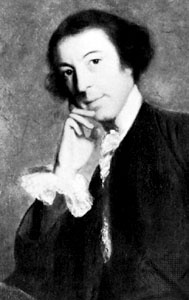Walpole, Horace, 4th earl of Orford
British author
original name Horatio Walpole
born Sept. 24, 1717, London
died March 2, 1797
 English writer, connoisseur, and collector who was famous in his day for his medieval horror tale The Castle of Otranto, which initiated the vogue for Gothic romances. He is remembered today as perhaps the most assiduous letter writer in the English language.
English writer, connoisseur, and collector who was famous in his day for his medieval horror tale The Castle of Otranto, which initiated the vogue for Gothic romances. He is remembered today as perhaps the most assiduous letter writer in the English language.The youngest son of the prime minister Sir Robert Walpole, he was educated at Eton and at King's College, Cambridge. In 1739 he embarked with his Eton schoolmate, the poet Thomas Gray (later to write “An Elegy Written in a Country Church Yard”), on a grand tour of France and Italy, in the midst of which they quarrelled and separated. They were later reconciled, and Walpole remained throughout his life an enthusiastic admirer of Gray's poetry. On his return to England in 1741, Walpole entered Parliament, where his career was undistinguished, although he attended debates regularly until 1768. In 1791 he inherited the peerage from a nephew, a grandson of Robert Walpole. He remained unmarried, and on his death the earldom became extinct.
The most absorbing interests of his life were his friendships and a small villa that he acquired at Twickenham in 1747 and transformed into a pseudo-Gothic showplace known as Strawberry Hill. Over the years he added cloisters, turrets, and battlements, filled the interior with pictures and curios, and amassed a valuable library. The house was open to tourists and became widely known in Walpole's own lifetime. He established a private press on the grounds, where he printed his own works and those of his friends, notably Gray's Odes of 1757. Strawberry Hill was the stimulus for the Gothic revival in English domestic architecture.
Walpole's literary output was extremely varied. The Castle of Otranto (1765), which was first published anonymously, succeeded in restoring the element of romance to contemporary fiction. In it he furnished the machinery for a genre of fiction wherein the wildest fancies found refuge. He also wrote The Mysterious Mother (1768), a tragedy with the theme of incest; amateur historical speculations such as Historic Doubts on the Life and Reign of King Richard the Third (1768); and a genuine contribution to art history, Anecdotes of Painting in England, 4 vol. (1762–71).
His most important works were intended for posthumous publication. His private correspondence of some 4,000 letters constitutes a survey of the history, manners, and taste of his age. Walpole revered the letters of Mme de Sévigné (1626–96) and, following her example, consciously cultivated letter writing as an art. His most substantial correspondence was with Horace Mann, a British diplomat whom Walpole met on his grand tour and with whom he maintained contact for 45 years, although the two never met again. Walpole's correspondence, edited by W.S. Lewis and others, was published in 48 volumes (1937–83).
Walpole also left Memoirs (first published 1822–59) of the reigns of George II and III, a record of political events of his time.
Additional Reading
R.W. Ketton-Cremer, Horace Walpole: A Biography, 3rd. ed. (1966), provides the fullest examination of Walpole's life.
- Giacomo della Porta
- Giacomo Doria
- Giacomo Leopardi
- Giacomo Manzù
- Giacomo Matteotti
- Giacomo Meyerbeer
- Giacomo Puccini
- Giacomo Serpotta
- Giacomo Torelli
- Giacosa, Giuseppe
- Giaever, Ivar
- Gia Long
- Giamatti, Paul
- Giambattista Basile
- Giambattista Bodoni
- Giambattista della Porta
- Giambattista Giraldi
- Giambattista Marino
- Giambattista Vico
- Giambologna
- Giambono, Michele
- Gianantonio Guardi
- Giancana, Sam
- Gian Carlo Menotti
- Gian Domenico Cassini